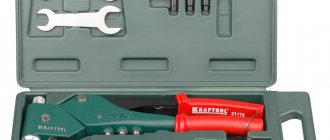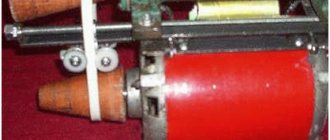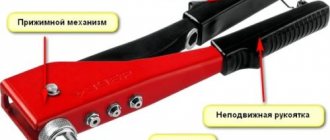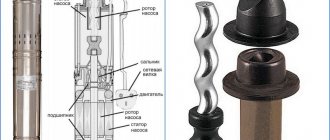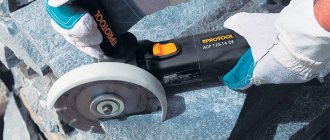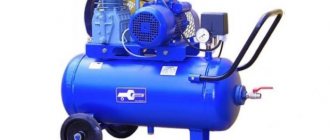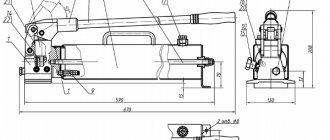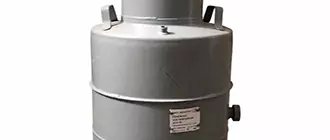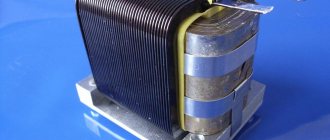When working in a warehouse, when it is necessary to lift small loads, it is convenient to use a manual chain hoist.
It is attractive with high functionality and elegant design. The equipment is equipped with a manual drive. The product consists of fixed and movable blocks.
Also included in the package:
- mechanism for lifting loads;
- hook;
The simple principle of operation is based on hanging a load on a hook, after which it is raised, moved and lowered using an easy-to-use mechanism.
The basis of the mechanism can be three types of gears:
- gear;
- lever;
- worm;
Their uninterrupted operation is based on the principle of closed circuit operation. Additional operational reliability is guaranteed by a well-thought-out brake system. It completely eliminates the potential for spontaneous lowering of a load suspended on the hoist.
When using models of this equipment together with a cat, it is ready for use both in open space and indoors. The equipment can be used to move along monorail tracks of the I-beam type.
When choosing this type of hoist, you should take into account the restrictions on using the manual version of such equipment. Including restrictions on cargo weight and lifting height, which must be specified in additional documentation and operating instructions.
At the same time, manual hoists are distinguished by their readiness to work successfully in a minimal working space, the reliability of all constituent elements, and ease of use, eliminating the need for preliminary training.
What is a manual hoist and where is it used?
Electrical diagram of a VAZ 2115 car
A manual hoist is used to lift and lower all kinds of loads when performing loading and unloading, installation, repair and construction work.
The unit can be operated at temperatures from -20 to +40 degrees. You can use a manual hoist to move loads in a horizontal plane if the mechanism is equipped with a cat. The design of a manual hoist includes a body with a mechanism for lifting loads, as well as a hook suspension from which the load is suspended. When lifting a load, a gear-gear transmission operates, which is manually activated by a chain thrown over a sprocket. The drive and movable sprockets of the hook suspension are wrapped around a welded or plate load chain. The manual hoist has a brake that prevents the spontaneous lowering of a lifted load.
The manual hoist has a wide range of lifting capacities and lifting heights. Structurally, a manual hoist is designed to be used by one person. Manual hoists are commercially produced with the following parameters: load capacity from 500 to 5000 kg, lifting height from 3 to 12 m. A manual hoist is a very useful and, in some cases, necessary device, which is installed in small car repair shops, used in small construction and other facilities. In case of failures in the supply of electrical energy in production, manual hoists turn out to be indispensable devices.
However, manual hoists have some disadvantages. For example, mechanisms require physical effort from workers, and are also inferior to electric models in terms of speed. Based on the type of suspension, manual hoists can be divided into the following categories:
- Mobile. They are suspended from trolleys that move on I-beams fixed to the object.
- Stationary. They are attached to the structure using the top hook.
Manual gear hoists are lifting mechanisms that consist of a gearbox and chain hoist, drive and brake mechanisms, load and traction round-link chains, and a movable block suspension with a hook.
The gearbox of the device is a two-stage, two-flow coaxial cylindrical gearbox with a load-bearing disc brake on the input shaft. This is required for smooth lowering and automatic stopping of the load when operating a manual hoist.
These hand-held devices can be hung permanently on a special hook or equipped with a mobile cat cart.
Category: Interesting » Industrial equipment
What is the difference between a manual gear hoist?
It is very difficult for a person who has never dealt with lifting mechanisms before to decide which type of device is best to choose from the existing ones. And there are really a lot of options, here are both lever hoists and worm hoists, but the most interesting from the point of view of operating the process of lifting a load is a manual gear chain hoist, stationary or mobile. The fact is that the vast majority of traction devices involve direct interaction between the operator and the mechanism. In other words, you either need to press the lever or turn the handle. The gear type we are considering is a completely different matter. This kind of hoist can be located at any height, and the operator controls the up and down movement of the hook from a distance by rotating a special pulley or simply pulling a closed traction chain.
All that is needed for the gear lifting mechanism to work is a ring to which the upper locking hook can be attached. In addition, the hoist can also be attached to a special carriage moving on rollers along an I-beam (the movement will also be controlled using an endless traction chain). Lifting the load vertically and moving it horizontally is carried out from the operator’s level up to a height of 12 meters, while lever and worm devices force the user to rise to one or another height
. A separate position in the list of traction mechanisms is occupied by hoists - types of hoists with an electric drive and a control panel. However, since they do not belong to hand-held devices, we will not consider them.
Elektrotal
Wheels for VAZ 14
Electric hoists can be stationary, portable and mobile. The former are used only for lifting loads; they are attached to the beams or floors of the workshop. Portable electric hoists are suspended from the top hook, similar to manual hoists.
The electric hoist consists of a drum for winding rope, a pulley and a trolley moving on a monorail.
Electric hoists, unlike manually driven hoists, have a more complex design and are driven by an electric motor.
Electric hoists are used for servicing machines when installing heavy parts and devices for processing, as stationary lifting devices during installation and disassembly of equipment, etc.
Electric hoists mounted on trolleys are called hoists. Carts can be manually or electrically driven for movement.
An electric hoist (telpher) is an electric winch (Fig. It consists of a trolley, an electric lifting motor, a gearbox, an electromagnetic brake, a drum for winding the cable ST) and a clip with a hook.
Electric hoists can be installed on crane beams, rotary cantilever beams, cantilever cranes moving along rail tracks.
Electric hoist 9 moves along the lower flanges of the supporting I-beam. The drive is connected to the second drive wheel by a transmission shaft 8 without intermediate supports.
An electric hoist (telpher) is an electric hoist (Fig. I, a), which not only lifts the load, but also moves it along a single-rail track located near the ceiling of the workshop. It consists of a trolley, a lifting electric motor, a leedductor, an electromagnetic brake, a reel for winding - J & HH cable and a clip with a hook. The hoist control buttons are located at the level of the worker’s chest.
Electric hoist 9 moves along the lower flanges of the supporting I-beam. The drive is connected to the second drive wheel by a transmission shaft 8 without intermediate supports.
The electric hoist consists of a drum for winding rope, a pulley and a trolley moving on a monorail.
Electric hoists are supplied with a manufacturer's passport, which contains their technical characteristics. A nameplate indicating the load capacity, lifting height, year of manufacture and serial number is attached to the electric hoist.
The electric hoist consists of two structurally related mechanisms: lifting and moving, each of which is driven by its own engine. The electric hoist moves along an I-beam on running wheels, which are driven by engine 5 through a spur gearbox. In the simplest electric hoists, braking devices are not installed on the movement mechanisms. Mechanical stops limit the movement of the hoist R on both sides.
Electric hoists (Fig. 3) are used for lifting and horizontal movement of loads. They are equipped with two electric motors to lift and move loads. The hoists are hung on I-beams.
Electric hoists can operate as stationary ones, being attached to floor beams or to specially laid beams. In cases where, in addition to lifting the load, it is also required to move it horizontally, electric hoists are attached to trolleys (cats) with a manual movement mechanism or to trolleys with an electric drive. Current supply is carried out by a flexible cable (with a short travel distance) or using trolleys located on brackets parallel to the monorail track. Electric hoists suspended from electrically driven trolleys are called hoists.
Electric hoist, telpher, electric hoist
Electric hoists are designed for lifting and horizontal movement of cargo along a monorail track indoors and under a canopy at ambient temperatures from -40 to +40° C. They are used as an independent mechanism, as well as as part of suspended and support crane beams, cantilever, gantry and other cranes. They differ in load capacity, height, design, as well as operating conditions. Hoists are widely used in both small warehouses and large industrial enterprises. They are in many ways superior to their manual counterparts, have greater functionality and are faster.
- Electric hoists Bulgarian
Telphers and electric motors ELMOT AD - Chinese electric hoists
- Russian electric hoists
- Ukrainian electric hoists
In the CIS countries, electric rope hoists with one lifting mechanism with a load capacity from 0.25 to 12.5 tons are manufactured, which use double, quadruple and double pulley blocks, as well as hoists with two lifting mechanisms with double single, double and triple pulley blocks.
Electric hoists are manufactured in various designs: A - the electric motor is located inside the drum; B - electric motor is built into the drum; B - the electric motor is built into the drum, an additional load-bearing brake is provided; G - electric motor outside the drum.
Electric hoists are manufactured for general use and special ones (high-lifting, explosion-proof) for moving along curved routes and along straight paths. Some hoists can be equipped with a two-speed motor, microdrive, brake on the movement mechanism, etc.
Operating mode group for electric hoists - 3M according to GOST 28835 (explosion-proof hoists - 2M). Type of current - three-phase 380 V, frequency 50 Hz. The hoists are powered via a flexible cable. The hoists are controlled using a pendant four-button remote control. Electric hoists are equipped with electromagnetic shoe or disc brakes.
We can also offer you a wide range of components and spare parts for this type of equipment.
If you need to buy an electric hoist or other lifting equipment, contact our specialists and get more detailed information. Our managers will always be able to advise and select you a hoist that will meet all the necessary requirements for the upcoming operation.
| Catalog of lifting equipment (PDF file): |
Special drive shaft. Drive chain and drive wheel
The hoist itself is suspended above the load itself, which must be lifted using a special trick. The lifting chain will be independently attached to the load. At the moment when we pull the drive chain, the drive wheel itself begins to rotate and rotates along the drive shaft, which begins to drive the gears, and at this time they turn the wheel of the lifting chain itself, which lifts the load itself.
It is worth taking a closer look at how gears produce the greatest concentration of lifting force in themselves, which is transmitted to the lifting chain. This drive chain is attached to a specialized segment on the drive wheel itself. The moment we pull, it begins to turn. The drive wheel is attached to a special friction plate, which is screwed to the ratchet.
At the moment when the plate and the ratchet begin to rotate together, the lock will fall into the teeth of the ratchet, preventing the wheel from unscrewing in the other direction under the influence of the weight of the load itself. With each process of transferring forces from one wheel to another, the force received from the drive chain increases several times.
The drive wheel is also mounted on the transfer shaft. As soon as the wheel begins to turn, it begins to drive the entire shaft. At the other end of this shaft there is a small and toothed gear, on which there are about 5 teeth at once. At the moment when it begins to make turns, the force transmitted by the action of the chain through a special drive wheel begins to increase rapidly. In this way, it increases in a special ratio of 7 to 5. A small toothed gear begins to drive the other two gears from the remaining wheels simultaneously.
Thus, the driving force of a small gear begins to be evenly transmitted by two wheels at once instead of one. A small gear immediately begins to drive 18 teeth, which are located on the remaining wheels. In turn, either of the two wheels has a small wheel at the back, which includes four teeth at once, increasing the total impact force by 18 to four.
These small wheels begin to drive a second wheel with 19 teeth in it, which begins to concentrate all the force on several links in the lifting chain attached to the last drive wheel. With the help of all these large and small wheels, the force from the drive traction can increase as much as thirty times.
A manual hoist is a fairly simple mechanism. It consists of a number of gears and two chains. A chain hoist makes an increase in total force as a result of the process of transforming a small number of forces that are applied over an overall length into a larger force that is applied over a smaller length.
Manual hoist - how it works and how it works.
The design of the manual hoist has two chains of different lengths.
One for which you need to pull, the other for lifting the load. The force generated when you pull on a 30-link chain increases your lifting force by 30 times. How does this happen? The winch itself is suspended above the load that needs to be lifted. The lifting chain is attached to the load. When we pull the hand chain, the large wheel turns and turns the drive shaft, which drives the gears. They, in turn, turn the wheels of the lifting chain, which lifts the load.
To understand how it works, you will have to disassemble the gear hand hoist into pieces. The traction chain is attached to several specially made gaps in the large wheel. As soon as we pull it, it starts to turn it. This large wheel screws tightly onto a friction plate that is attached to the ratchet. Once the large wheel, plate and ratchet begin to turn together, the locking mechanism engages the teeth of the ratchet, preventing the large wheel from spinning back under the weight of the load. And this is just the beginning.
With each transfer of force from wheel to wheel, the force received from the hand pull chain increases and increases all the time. The large wheel is also attached to the drive shaft. As soon as the wheel turns, it drives the shaft. At the other end of the shaft is a small wheel with only five teeth. As it begins to turn, the force applied to the big wheel by the traction chain increases. Thus, it increases in a ratio of 7:5. As a result, this small wheel turns with a force greater than that which presses on the teeth of the wheel. To increase the pressing force, this wheel drives 2 identical wheels at the same time. Thus, the pressing force of the small wheel is distributed over 2 wheels instead of one. The small wheel drives 18 teeth on each of the other wheels. These wheels are special because behind them there is another small wheel with 4 teeth, which in turn also increases the force of impact in the ratio of 18:4.
But that is not all. These small wheels drive another large 19-tooth wheel, which concentrates all the power on several links of the load chain attached to the final sprocket. Thanks to all these wheels, the force increases until it increases 30 times.
Video - how it works
Not every load can be lifted manually or even with the help of a system of blocks, for the installation of which, by the way, you still need to find a place in the room, and often in everyday life a manual gear hoist .
Features of manual hoist
It is worth carefully familiarizing yourself with what a manual hoist consists of, as well as what principle of operation it can perform.
A manual chain hoist looks like a mechanical device that is used when lifting particularly heavy loads, equipment and various objects to various heights. It includes several circuits at once. One is the one for which the traction process is carried out, and the second is the one that carries out the lifting of the load. The force that can be generated while you pull the chain is 30 links at once, and also increases their lifting force by as much as thirty times.
The hoist will qualitatively increase the force, as a result of which the process of changing a small level of effort will be developed to the maximum applied to a large drive chain, which is attached to a shorter length of the load chain.
The manual chain hoist will include:
- Toothed gears.
- Load chain.
- Wheel made from a lifting chain.
Electric hoist operating principle and application
Wednesday, December 23, 2015
Modern lifting mechanisms - hoists - can be manual or electric. Electric hoists are divided into mobile and stationary.
Unlike manual hoists, electric hoists can lift heavier loads. They have a higher rate of ascent. They are usually installed on monorail beams on special trolleys. Electric hoists are also called telphers and electric hoists.
The domestic market today offers predominantly electric hoists of Russian and Bulgarian production. Electric hoists have different dimensions and technical characteristics. Any customer chooses the mechanisms that are needed for the work he carries out.
Design features of electric hoists
Any electric hoist consists of the following elements:
- gearbox;
- hook suspension;
- coupling;
- lifting drum;
- running trolley;
- cargo rope;
- electrical equipment.
Such hoists are intended for lifting, lowering and moving loads in a horizontal plane. The mechanism moves along a monorail or stationary channel.
Terms of Use
Electric hoists can be used under a canopy at temperatures from minus 20 to plus 40 degrees Celsius. If the electric hoist is equipped with a protective motor and special equipment, then it can work indoors. These mechanisms cannot be used:
- for transporting people;
- in a room with vapors of acids and alkalis, which have a negative effect on electrical wiring;
- in a room with explosive and flammable vapors and gases;
- on sea and river vessels in conditions of roll and pitching.
Production managers and shop managers can look at the catalog of electric hoists on the Internet on specialized websites to make an informed choice. Depending on which traction element is used, electric hoists can be chain or rope. Such mechanisms are stationary and mobile.
Application of electric hoists
Electric hoists are widely used in many industries. These can be small warehouses or workshops of large enterprises. Telphers have proven themselves well in the market. Both domestic and Bulgarian mechanisms meet European standards. They are available in a wide range of models and options. They can be used everywhere.
The use of these mechanisms depends on the specific production in which they are involved. It can be:
- construction sites,
- factory floors,
- store warehouses and similar places.
If the mechanism is made in a moisture- or dust-proof, explosion-proof design, it can be used in aggressive environments.
The hoist acts as an independent device for lifting loads, and in beam cranes, jib cranes and others, as a lifting mechanism.
Modern electric hoists of domestic and foreign production
The domestic lifting industry produces electric rope hoists of the TE type. Their design was developed back in the fifties of the last century. Despite such a considerable age, such hoists are produced and find consumers.
Along with products from Korean and Polish manufacturers, Bulgarian-made electric hoists in chain design are in particular demand in our country. Such hoists are low noise and compact, light weight and low height. Bulgarian produced a series of electric hoists called “Shipka” especially for Russia. Bulgarian factories Yantra, Balkanskoe Ekho, Skladova Tekhnika and others also operate for the Russian market of lifting equipment.
Design and principle of operation of the mobile manual hoist TRSHAp-0.5.
The mobile manual hoist consists of a cat 9, two power jaws 8 and 10, an earring 32 connecting the hoist to the cat, a lower suspension 14, a gearbox with a load brake, a housing 11, a load sprocket 12 mounted in bearings, a traction sprocket 1, a load chain 15 , traction chain 16 and casing 6, rotating in shell 7.
The gearbox is a two-stage, two-flow cylindrical coaxial gearbox with external gears. The brake is automatic, disc, load-resistant and consists of a hub 20 screwed onto a gear shaft 13, a cup 18 mounted on the cheek 8. Friction lining 5 is located between the hub 20 and cup 18, spring 4 presses the hub. Traction sprocket 1 is freely mounted on the gear shaft and engages with the hub and gear shaft. Cam 3 is mounted on the gear shaft and engages with traction sprocket 1.
Rotating clockwise, traction sprocket 1 with two protrusions 2 engages with cam 3, mounted through triangular splines on gear shaft 13 and transmits rotation to it. At the same time, the traction sprocket 1, with its three ribs 21, engages with the protrusions 22 on the hub 20 and also rotates it. Spring 4, located between the traction sprocket 1 and the hub 20, presses the hub through the friction lining 5 to the cup 18. If the hub 20 is in such a position that its three protrusions 22 do not contact the ribs 21 of the traction sprocket 1, then under the action of the compressed spring 4 The hub 20, screwed onto the gear shaft 13, rotates around its axis and engages with the ribs 21 of the traction sprocket with the protrusions 22. Thus, the gear shaft 13 and the hub 20 rotate simultaneously in one direction due to the small spring stiffness: there is minimal friction between the hub 20, the friction lining 5 and the cup 18.
As the traction sprocket continues to rotate clockwise, the load rises. When the rotation of the traction sprocket stops, the cargo sprocket begins to rotate under the influence of the load and transmits counterclockwise rotation to the gear shaft through the gearbox. Thus, the cam 3, mounted through the splines on the gear shaft 13 through the projections 2 on the traction sprocket 1, turns it counterclockwise, and the compressed spring 4 slows down the hub 20, and the gear shaft 13 screws the hub onto itself, which leads to operation brakes and stopping the load.
While the traction sprocket rotates counterclockwise, the brake remains in a tightened state until the traction sprocket, through three ribs 21 through protrusions 22 on the hub 20, begins to twist it from the gear shaft 13 - the adhesion force in the friction pairs decreases, and the suspended cargo When the rotation of the traction sprocket stops, the friction pairs are tightened under the action of the load and the forces arising on the friction surfaces of these pairs do not allow the hub 20 and the gear shaft 13 to rotate relative to the cup 18 fixed to the cheek 8 of the hoist. Consequently, the brake is applied and the load stops.
The cat 9 consists of two cheeks 34 and an axis 35. In the cheeks 34, rollers 33 are installed on rolling bearings.
The design and operating principles of mobile manual gear chain hoists TRShBp with a lifting capacity of 1, 2 and 3 tons are similar to the design and operating principles of the TRSHAP hoist. The differences are: a) in the number of branches of the load chain - 2 branches TRShBp-2.0 and 3 branches TRShBp-3.2; b) in the design of the lower hook hanger; c) in the design of the cat - in one-, two- and three-ton hoists, the cats have a drive for the movement mechanism, unlike half-ton hoists, which do not have a drive.
Figure 2.10.10. Construction of a mobile manual hoist TRShBp-1.0.
Cat 9 of the TRShBp-1.0 hoist consists of cheeks 34 and 36, a spacer 35 with an axis 32 of attachment to the hoist body. In the cheek 36, driven rollers 33 are installed on rolling bearings. In the cheek 34, a movement mechanism is mounted, consisting of a traction sprocket 25, a traction chain 26, a chain limiter 27, drive rollers 28, on the flanges of which there are toothed rims that engage with the pinion shaft 29. The cat of mobile hoists TRShBp-2.0 and TRShBp-3.2 has a similar device.
Figure 2.10.11. Construction of a manual mobile hoist TRShBp-2.0.
Figure 2.10.12. Construction of a mobile manual hoist TRShBp-3.2.
The electric hoist consists of 1
and movement
2,
hook suspension
3,
push-button station
4,
cargo rope 5. The electric hoist lifting mechanism is controlled using a push-button station suspended from the body.
The current supply is made in the form of trolls or flexible cables. The lifting mechanism is suspended from the traverse 8,
it consists of an electric motor, a drum
9
(or drum motor), a gearbox
10,
an electrical cabinet
11,
a hook suspension
3.
The drum or drum motor is placed in a cast or welded hoist body
12.
On the traverse
8
elements of the lifting mechanism are also fixed - equalizing block
14
and a panel with a limit switch.
The location of the drum or motor drum relative to rail 13
can be transverse (Fig. 2 and 3) or longitudinal.
The movement mechanism includes a drive idle
trolley 7, which are pivotally connected to a cross beam
8.
Guide rollers 75 and a buffer
16
are included in the drive and idle trolleys of the hoist movement mechanism. To ensure work safety, hoists are equipped with appropriate devices, most of which operate automatically. With the help of these devices, the following are switched off: the lifting mechanism when the hook suspension reaches the uppermost position, the movement mechanism when the hoist stops approach the stops.
Figure 2.10.13.
Figure 2.10.14 Electric hoist design
Figure 2.10.15 Electric hoist with flange mounting of the electric motor of the lifting mechanism to the housing.
In Fig. 2.10.15 shows an electric hoist with a flange mounting of the electric motor 15 to the housing 12. This design is less common in practice than with a drum motor, due to its smaller compactness, since the design of the drum motor involves placing a built-in electric motor inside the drum.
I-beams are used as a single-rail track for hoists with a load capacity of 1 - 10 tons. The I-beam number is assigned depending on the lifting capacity of the hoist.
It should be taken into account that modern production of lifting machines is based on the creation of block and unified structures (hook suspensions, couplings, brakes, etc.), which make it possible to obtain the highest technical and economic effect in the manufacture and operation of these machines. A block design is a design consisting of independent block units connected to each other by means of easily removable connections. The use of block structures makes it possible to produce complete components of mechanisms, which leads to the specialization of individual workshops and factories. Specialization of production, in turn, ensures an increase in the quality of manufactured components. The use of block structures makes it possible to easily separate a unit requiring repair from the machine without disassembling adjacent units. If spare units are available, a faulty unit can be replaced in a short time. In addition, the use of block structures makes it possible to unify individual components and parts as much as possible.
Lifting mechanisms have some design features. Wheel hub 7 is made in the form of an elongated bushing 8,
inside which a high-speed gearbox shaft
2 is placed,
and on its outer surface there is a cast iron drum 7 with a thread, a rope and a bar
12
with a screw
27.
The key
20
ensures the transmission of movement from the wheel 7 to the drum 7. The body 77 of the hoist is also cast with two flanges , to which the electric motor flange is attached to the left with screws
30
and
31
, and the gearbox housing
10
.
The supports for sleeve 8
are bearings
21,
for shaft
3 -
bearings
23
and
24
, and for shaft 5 - bearings
13
and
22.
Bearing 22
is a roller bearing
to self-align
move to the right within small limits. Bearings 13, 21, 23
and
24
can be radial ball bearings, for example, series 200, 300, 400. The cover
28
must allow bearing
13
to move to the right, i.e.
there should be a gap of 0.5..L
mm between the bearing and the cover.
The size of this gap is regulated by spacers 29.
Screws 19
and
25
secure
and
the cover 28
to
the body part 26.
It is also necessary to pay attention to the fact that all parts placed on the gearbox shafts and hoist have no axial movements, which is ensured by locks 32, 38, 39,
spacer rings
33, 34, 35
and covers
37.
Output ends of the shaft 3
sealed with cuffs
18.
Vent plug 77 with gasket:
- located in the very top part of the gearbox housing, and the drain plug 16
with gasket;
-at the very bottom. It is possible to install gaskets of various shapes (flat and round) between the flanges of the hoist and gearbox housings. The disadvantage of the design is its large dimensions and the presence of a long high-speed (and, therefore, small diameter) shaft.
In Fig. 10.13.16 shows an electric hoist with an electric motor built into the drum 19
and disc brake 75. The gearbox is two-stage, the high-speed stage is with external gearing, and the low-speed stage is with internal gearing.
The steps are formed by pairs of wheels 3, 4, 6
and 7, respectively, in mesh.
There are: 3 -
high-speed gear shaft and
5 -
intermediate axis of the gearbox, the supports of which are bearings
13
and
25;
bearings
25 are
needle type (to reduce the dimensions of wheel hub
4).
Bearings
13
are simultaneously supports for drum 7, bearings
9 are
supports for the hoist body.
The gearbox housing 10
is closed by a cover
14.
The disc brake is attached to the hoist housing 77 with screws (not marked in Fig. 7).
The gearbox housing has a drain plug 16
and a vent plug 7 7. The high-speed shaft is sealed with cuffs
18
and
24.
The gearbox housing is sealed with a cuff
20.
Positions
2 -
key,
21 -
spacer ring,
22, 23 -
retaining rings.
On the drum 7 there are two strips 12,
i.e.
The hoist is equipped with a double chain hoist. The use of motor drums (Fig. 7) makes it possible to reduce the axial dimensions of the lifting mechanisms, but impairs the repairability of the hoist. In Fig. 7, the stator of the motor 19
is fixed in a stationary housing inside the drum, which eliminates the current collector from the design and increases the reliability of the mechanism, however, it is necessary to use
large-diameter 9
Figure 2.10.16 Hoist lifting mechanism with gear reducer and flange-mounted electric motor.
The ball-bearing supports of the electric hoist are lubricated with grease through grease fittings or by directly inserting it into the bearing units. The gear drives of the gearbox are lubricated with liquid lubricant from an oil bath. The oil bath level is controlled using control plugs. Planetary gears provide a reduction in design dimensions, especially at large gear ratios. Such multi-link gear mechanisms necessarily have wheels with moving geometric axes, which are called planetary or satellites. The moving link in which the satellite axes are located is called the carrier. The wheel rotating around a fixed axis, on which the satellites roll, is called the central wheel. The fixed central wheel is called the support wheel. As a rule, planetary mechanisms are made coaxial. Unlike mechanisms with fixed axles, the gear ratio of a planetary gearbox depends not only on the number of teeth and the sign of their ratio, but also on the number of steps between the central wheels (with the carrier stopped). Therefore, each specific planetary gearbox design has its own, quite specific, expression for calculating the value of the gear ratio, written in terms of the number of teeth (or wheel radii).
This issue is discussed in more detail in the works. Schemes must be selected taking into account the quality of simple planetary gears from which the gear reducer is assembled, as well as the purpose of the mechanism, the conditions and mode of its operation, the installation location, as well as taking into account the type of transmission and type of gearing, the distribution of the total gear ratio among the stages and the choice of the number of stages , estimates of friction losses, vibration and elasticity of links, etc. Therefore, in the general case, the choice of a scheme taking into account many factors can only be performed by optimization methods using a computer.
The carrier here rotates freely in the supports without transmitting movement. In a kinematic study, this mechanism is divided into two simple ones: the first includes central wheels 7, 5,
satellite
2
and carrier
6;
the second - consists of a central wheel
4,
a satellite
3
and a carrier
6.
With a stationary wheel
5
, the number of degrees of freedom is
W
= 1 and the total gear ratio of the gearbox.
This scheme allows, by selecting the appropriate numbers of teeth, to obtain large gear ratios (> 100) with high efficiency and great compactness.
When designing planetary gearboxes, special attention should be paid to the accuracy of manufacturing of assembly units, assembly performance and transmission efficiency. Placing the gearbox in the hoist drum places increased demands on sealing. In Fig. 8 drove b
has a collapsible design. The sun floating gear helps equalize the load between the satellites. The satellites are mounted on plain bearings. Holes are provided in the drums for filling and draining liquid lubricant.
The designs of individual units, for example gearboxes - coaxial three-stage planetary, and other features of such hoists are presented in detail in the works.
Rice. 2.10.17. A lifting mechanism with an electric motor, the flange of which is fixed to the hoist body.
The mobile manual hoist consists of a cat 9, two power jaws 8 and 10, an earring 32 connecting the hoist to the cat, a lower suspension 14, a gearbox with a load brake, a housing 11, a load sprocket 12 mounted in bearings, a traction sprocket 1, a load chain 15 , traction chain 16 and casing 6, rotating in shell 7.
The gearbox is a two-stage, two-flow cylindrical coaxial gearbox with external gears. The brake is automatic, disc, load-resistant and consists of a hub 20 screwed onto a gear shaft 13, a cup 18 mounted on the cheek 8. Friction lining 5 is located between the hub 20 and cup 18, spring 4 presses the hub. Traction sprocket 1 is freely mounted on the gear shaft and engages with the hub and gear shaft. Cam 3 is mounted on the gear shaft and engages with traction sprocket 1.
Rotating clockwise, traction sprocket 1 with two protrusions 2 engages with cam 3, mounted through triangular splines on gear shaft 13 and transmits rotation to it. At the same time, the traction sprocket 1, with its three ribs 21, engages with the protrusions 22 on the hub 20 and also rotates it. Spring 4, located between the traction sprocket 1 and the hub 20, presses the hub through the friction lining 5 to the cup 18. If the hub 20 is in such a position that its three protrusions 22 do not contact the ribs 21 of the traction sprocket 1, then under the action of the compressed spring 4 The hub 20, screwed onto the gear shaft 13, rotates around its axis and engages with the ribs 21 of the traction sprocket with the protrusions 22. Thus, the gear shaft 13 and the hub 20 rotate simultaneously in one direction due to the small spring stiffness: there is minimal friction between the hub 20, the friction lining 5 and the cup 18.
As the traction sprocket continues to rotate clockwise, the load rises. When the rotation of the traction sprocket stops, the cargo sprocket begins to rotate under the influence of the load and transmits counterclockwise rotation to the gear shaft through the gearbox. Thus, the cam 3, mounted through the splines on the gear shaft 13 through the projections 2 on the traction sprocket 1, turns it counterclockwise, and the compressed spring 4 slows down the hub 20, and the gear shaft 13 screws the hub onto itself, which leads to operation brakes and stopping the load.
While the traction sprocket rotates counterclockwise, the brake remains in a tightened state until the traction sprocket, through three ribs 21 through protrusions 22 on the hub 20, begins to twist it from the gear shaft 13 - the adhesion force in the friction pairs decreases, and the suspended cargo When the rotation of the traction sprocket stops, the friction pairs are tightened under the action of the load and the forces arising on the friction surfaces of these pairs do not allow the hub 20 and the gear shaft 13 to rotate relative to the cup 18 fixed to the cheek 8 of the hoist. Consequently, the brake is applied and the load stops.
The cat 9 consists of two cheeks 34 and an axis 35. In the cheeks 34, rollers 33 are installed on rolling bearings.
The design and operating principles of mobile manual gear chain hoists TRShBp with a lifting capacity of 1, 2 and 3 tons are similar to the design and operating principles of the TRSHAP hoist. The differences are: a) in the number of branches of the load chain - 2 branches TRShBp-2.0 and 3 branches TRShBp-3.2; b) in the design of the lower hook hanger; c) in the design of the cat - in one-, two- and three-ton hoists, the cats have a drive for the movement mechanism, unlike half-ton hoists, which do not have a drive.
Figure 2.10.10. Construction of a mobile manual hoist TRShBp-1.0.
Cat 9 of the TRShBp-1.0 hoist consists of cheeks 34 and 36, a spacer 35 with an axis 32 of attachment to the hoist body. In the cheek 36, driven rollers 33 are installed on rolling bearings. In the cheek 34, a movement mechanism is mounted, consisting of a traction sprocket 25, a traction chain 26, a chain limiter 27, drive rollers 28, on the flanges of which there are toothed rims that engage with the pinion shaft 29. The cat of mobile hoists TRShBp-2.0 and TRShBp-3.2 has a similar device.
Figure 2.10.11. Construction of a manual mobile hoist TRShBp-2.0.
Figure 2.10.12. Construction of a mobile manual hoist TRShBp-3.2.
The electric hoist consists of 1
and movement
2,
hook suspension
3,
push-button station
4,
cargo rope 5. The electric hoist lifting mechanism is controlled using a push-button station suspended from the body.
The current supply is made in the form of trolls or flexible cables. The lifting mechanism is suspended from the traverse 8,
it consists of an electric motor, a drum
9
(or drum motor), a gearbox
10,
an electrical cabinet
11,
a hook suspension
3.
The drum or drum motor is placed in a cast or welded hoist body
12.
On the traverse
8
elements of the lifting mechanism are also fixed - equalizing block
14
and a panel with a limit switch.
The location of the drum or motor drum relative to rail 13
can be transverse (Fig. 2 and 3) or longitudinal.
The movement mechanism includes a drive idle
trolley 7, which are pivotally connected to a cross beam
8.
Guide rollers 75 and a buffer
16
are included in the drive and idle trolleys of the hoist movement mechanism. To ensure work safety, hoists are equipped with appropriate devices, most of which operate automatically. With the help of these devices, the following are switched off: the lifting mechanism when the hook suspension reaches the uppermost position, the movement mechanism when the hoist stops approach the stops.
Figure 2.10.13.
Figure 2.10.14 Electric hoist design
Figure 2.10.15 Electric hoist with flange mounting of the electric motor of the lifting mechanism to the housing.
In Fig. 2.10.15 shows an electric hoist with a flange mounting of the electric motor 15 to the housing 12. This design is less common in practice than with a drum motor, due to its smaller compactness, since the design of the drum motor involves placing a built-in electric motor inside the drum.
I-beams are used as a single-rail track for hoists with a load capacity of 1 - 10 tons. The I-beam number is assigned depending on the lifting capacity of the hoist.
It should be taken into account that modern production of lifting machines is based on the creation of block and unified structures (hook suspensions, couplings, brakes, etc.), which make it possible to obtain the highest technical and economic effect in the manufacture and operation of these machines. A block design is a design consisting of independent block units connected to each other by means of easily removable connections. The use of block structures makes it possible to produce complete components of mechanisms, which leads to the specialization of individual workshops and factories. Specialization of production, in turn, ensures an increase in the quality of manufactured components. The use of block structures makes it possible to easily separate a unit requiring repair from the machine without disassembling adjacent units. If spare units are available, a faulty unit can be replaced in a short time. In addition, the use of block structures makes it possible to unify individual components and parts as much as possible.
Lifting mechanisms have some design features. Wheel hub 7 is made in the form of an elongated bushing 8,
inside which a high-speed gearbox shaft
2 is placed,
and on its outer surface there is a cast iron drum 7 with a thread, a rope and a bar
12
with a screw
27.
The key
20
ensures the transmission of movement from the wheel 7 to the drum 7. The body 77 of the hoist is also cast with two flanges , to which the electric motor flange is attached to the left with screws
30
and
31
, and the gearbox housing
10
.
The supports for sleeve 8
are bearings
21,
for shaft
3 -
bearings
23
and
24
, and for shaft 5 - bearings
13
and
22.
Bearing 22
is a roller bearing
to self-align
move to the right within small limits. Bearings 13, 21, 23
and
24
can be radial ball bearings, for example, series 200, 300, 400. The cover
28
must allow bearing
13
to move to the right, i.e.
there should be a gap of 0.5..L
mm between the bearing and the cover.
The size of this gap is regulated by spacers 29.
Screws 19
and
25
secure
and
the cover 28
to
the body part 26.
It is also necessary to pay attention to the fact that all parts placed on the gearbox shafts and hoist have no axial movements, which is ensured by locks 32, 38, 39,
spacer rings
33, 34, 35
and covers
37.
Output ends of the shaft 3
sealed with cuffs
18.
Vent plug 77 with gasket:
- located in the very top part of the gearbox housing, and the drain plug 16
with gasket;
-at the very bottom. It is possible to install gaskets of various shapes (flat and round) between the flanges of the hoist and gearbox housings. The disadvantage of the design is its large dimensions and the presence of a long high-speed (and, therefore, small diameter) shaft.
In Fig. 10.13.16 shows an electric hoist with an electric motor built into the drum 19
and disc brake 75. The gearbox is two-stage, the high-speed stage is with external gearing, and the low-speed stage is with internal gearing.
The steps are formed by pairs of wheels 3, 4, 6
and 7, respectively, in mesh.
There are: 3 -
high-speed gear shaft and
5 -
intermediate axis of the gearbox, the supports of which are bearings
13
and
25;
bearings
25 are
needle type (to reduce the dimensions of wheel hub
4).
Bearings
13
are simultaneously supports for drum 7, bearings
9 are
supports for the hoist body.
The gearbox housing 10
is closed by a cover
14.
The disc brake is attached to the hoist housing 77 with screws (not marked in Fig. 7).
The gearbox housing has a drain plug 16
and a vent plug 7 7. The high-speed shaft is sealed with cuffs
18
and
24.
The gearbox housing is sealed with a cuff
20.
Positions
2 -
key,
21 -
spacer ring,
22, 23 -
retaining rings.
On the drum 7 there are two strips 12,
i.e.
The hoist is equipped with a double chain hoist. The use of motor drums (Fig. 7) makes it possible to reduce the axial dimensions of the lifting mechanisms, but impairs the repairability of the hoist. In Fig. 7, the stator of the motor 19
is fixed in a stationary housing inside the drum, which eliminates the current collector from the design and increases the reliability of the mechanism, however, it is necessary to use
large-diameter 9
Figure 2.10.16 Hoist lifting mechanism with gear reducer and flange-mounted electric motor.
The ball-bearing supports of the electric hoist are lubricated with grease through grease fittings or by directly inserting it into the bearing units. The gear drives of the gearbox are lubricated with liquid lubricant from an oil bath. The oil bath level is controlled using control plugs. Planetary gears provide a reduction in design dimensions, especially at large gear ratios. Such multi-link gear mechanisms necessarily have wheels with moving geometric axes, which are called planetary or satellites. The moving link in which the satellite axes are located is called the carrier. The wheel rotating around a fixed axis, on which the satellites roll, is called the central wheel. The fixed central wheel is called the support wheel. As a rule, planetary mechanisms are made coaxial. Unlike mechanisms with fixed axles, the gear ratio of a planetary gearbox depends not only on the number of teeth and the sign of their ratio, but also on the number of steps between the central wheels (with the carrier stopped). Therefore, each specific planetary gearbox design has its own, quite specific, expression for calculating the value of the gear ratio, written in terms of the number of teeth (or wheel radii).
This issue is discussed in more detail in the works. Schemes must be selected taking into account the quality of simple planetary gears from which the gear reducer is assembled, as well as the purpose of the mechanism, the conditions and mode of its operation, the installation location, as well as taking into account the type of transmission and type of gearing, the distribution of the total gear ratio among the stages and the choice of the number of stages , estimates of friction losses, vibration and elasticity of links, etc. Therefore, in the general case, the choice of a scheme taking into account many factors can only be performed by optimization methods using a computer.
The carrier here rotates freely in the supports without transmitting movement. In a kinematic study, this mechanism is divided into two simple ones: the first includes central wheels 7, 5,
satellite
2
and carrier
6;
the second - consists of a central wheel
4,
a satellite
3
and a carrier
6.
With a stationary wheel
5
, the number of degrees of freedom is
W
= 1 and the total gear ratio of the gearbox.
This scheme allows, by selecting the appropriate numbers of teeth, to obtain large gear ratios (> 100) with high efficiency and great compactness.
When designing planetary gearboxes, special attention should be paid to the accuracy of manufacturing of assembly units, assembly performance and transmission efficiency. Placing the gearbox in the hoist drum places increased demands on sealing. In Fig. 8 drove b
has a collapsible design. The sun floating gear helps equalize the load between the satellites. The satellites are mounted on plain bearings. Holes are provided in the drums for filling and draining liquid lubricant.
The designs of individual units, for example gearboxes - coaxial three-stage planetary, and other features of such hoists are presented in detail in the works.
Rice. 2.10.17. A lifting mechanism with an electric motor, the flange of which is fixed to the hoist body.
Using hoists in life
In suburban farming you can find a considerable number of jobs where special lifting devices will act as a good assistant. First of all, when considering such a mechanism, a special thought arises about lifting such a heavy load to the attic window. These could be simple bags of pet food, agricultural blocks of hay, or even building materials to re-cover the entire roof.
And during the construction of a house, a manual type of hoist can be used well, especially during the construction of a frame structure. It is enough that you simply purchase a small crane, which will include a special mobile cantilever boom, or put together the same product from hand lumber, in which case you will have your own construction equipment. It and special reinforced concrete blocks under a strip foundation near a fence or building can be lowered in a special trench, as well as heavy types of pillars can be built vertically, and the bricks can be raised to the second level of the cottage under construction.
It is strictly forbidden to use a hoist to lift animals or people to great heights, as this would be a gross violation of safety rules.
In a garage, such a device is also quite useful in most cases, for example, in order to lift the body or remove the engine from the hood of a vehicle. Even in a modern apartment it is not difficult to find a use for such a useful device, especially if the house has high ceilings. In particular, the owner of both a scooter and a moped is able to lift his two-wheeled mobility device onto balconies located on the second floors.
With the help of an external boom, you can quite easily lift furniture to the upper platform in the house, either directly into the premises of a low-rise building, or, conversely, lower it to the lowest floor in the entrance. It is very easy to find the use of a hoist; the main thing is to choose the right device so that it can efficiently withstand the entire load that falls on it.
Purpose and design of manual hoist
The choice of mechanisms for vertical movement of cargo is quite diverse. Even for manual lifting, there are different types of hoists available to handle even the most demanding tasks. Depending on the purpose, you can choose a device capable of lifting significant weight or moving it in the desired direction. The ease of handling the load, its maximum weight and dimensions will influence the design of the hoist, which should ensure maximum productivity in work. Each of the mechanisms used has certain advantages and it is worth considering all their possible variations.
How does a manual gear hoist work?
The operating principle of the mechanism we are considering is extremely simple and therefore very reliable. An endless closed chain rotating through a pulley is thrown through a special traction wheel, which is located on the side of the hoist body. Then, through a toothed drive shaft, the torque is transmitted to two gears, which are necessary to capture the direction of rotation of the traction wheel. From them, through another gear, a load block with a sprocket is activated, through which a plate chain is thrown (it can be double or even triple, depending on the permissible load on the hoist).


